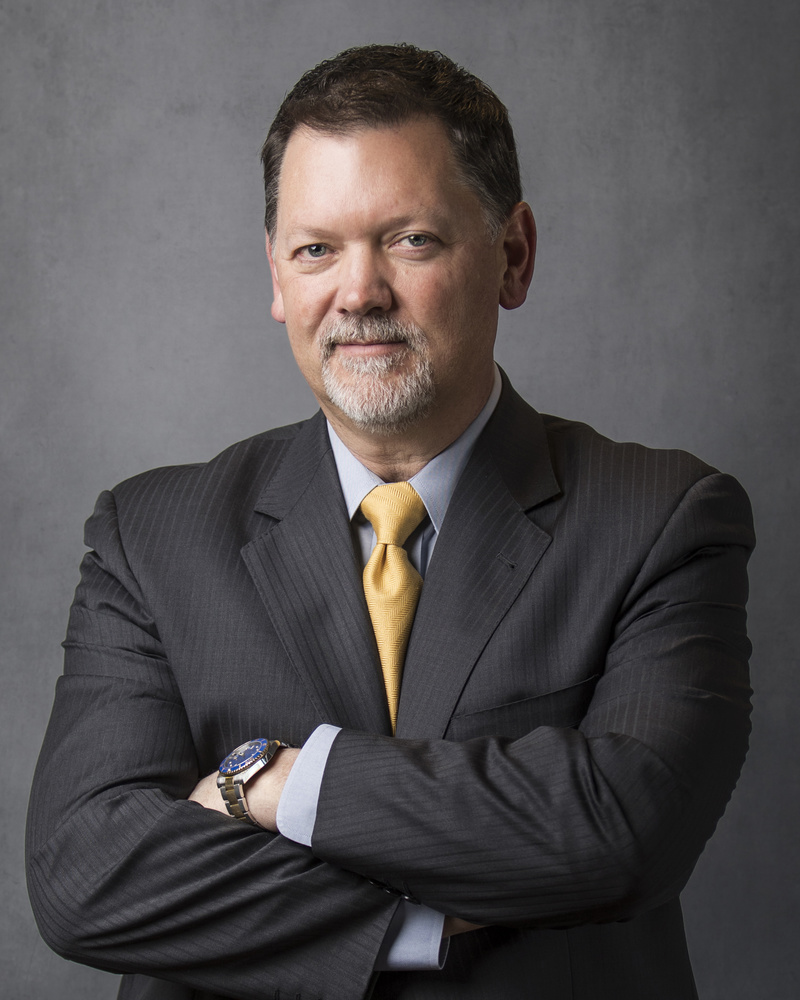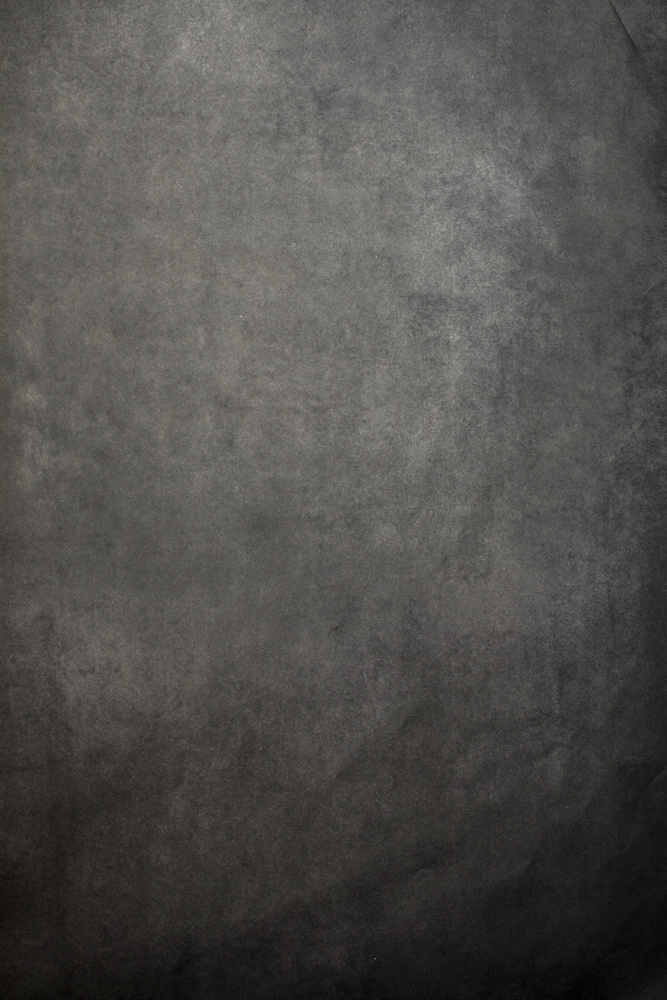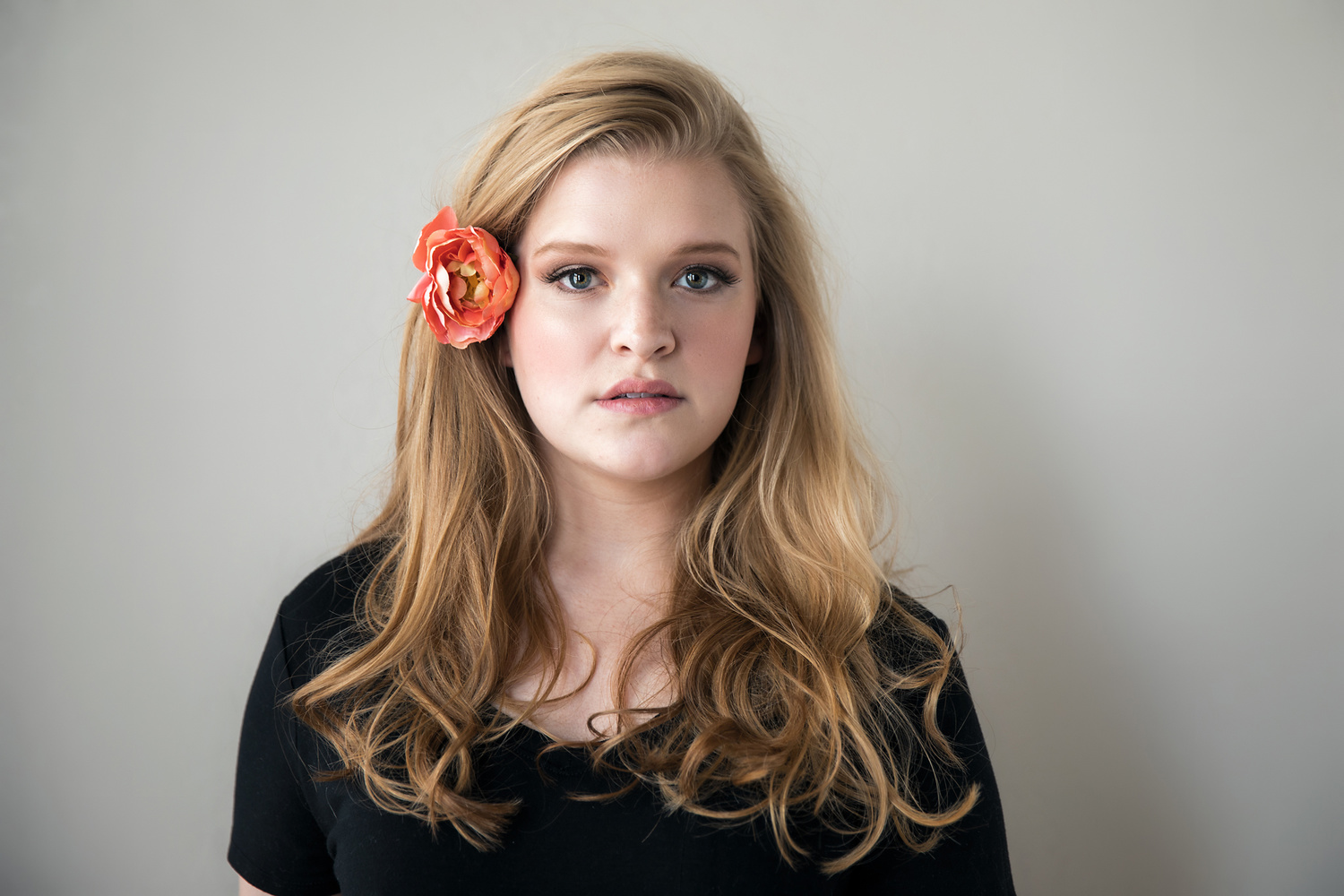Do you crave the look of a high-end, hand-painted portrait backdrop for your studio, but don't want to shell out the bucks for such a luxury? Why not grab your favorite roll of seamless paper and fake it ‘til you make it?
A Portable Solution
Before I had my own studio space, I worked mostly on location. My go-to setup for business portraits back then was a 54-inch wide roll of gray seamless paper. I could set it up in a flash without an assistant, grab the shot I needed, and then later enhance that plain backdrop in Photoshop with a texture that would fool the eye of most anyone into thinking I had used a gorgeous, hand-painted canvas backdrop. I did this for years, and it resulted in many happy clients, both in business portraits and more mainstream studio work.

A business portrait shot on gray seamless paper, with texture added in Photoshop.
Splurging on the Real Thing
When I opened my photography studio after many years of borrowing space and shooting on-location, I celebrated having my very own spread by splurging on a high-end backdrop, hand-painted by one of the most talented backdrop painters in the business, the one-and-only Sarah Oliphant. Sarah is a legend in the backdrop world. Her backdrops have been featured in magazines like Vogue and Vanity Fair, and in the works of such world-famous photographers as Annie Leibovitz and Mark Seliger. Each one is truly a work of art.
The backdrop I commissioned from her is a gorgeous, double-sided, two-tone gray masterpiece, and I am super happy I took the plunge and bought it. It has totally taken the place of that plain gray seamless paper in my studio work. Having it set up permanently in my studio has reduced my workload both physically and in post-production.
However, there are many times when I want to shake things up by adding a little color to my portrait work, especially in senior portraits or commercial work. I love to use a red backdrop, as well as teal or deep blue. If I were super rich, I would ask Sarah to paint me one of each color. If I were flush with the luxury of time and painterly talent, I might try to paint my own. Alas, I have none of these luxuries, but what I do have is seamless paper, and Photoshop skills.
The Seamless Solution
Seamless paper backdrops are super easy to get, economical, and they come in every color under the sun. My go-to seamless brand, Savage Universal, even offers them in multiple widths of 107, 86, 53 or 26 inches. And while they can look great on their own, especially for a high-fashion look, sometimes they need a little added drama when they are being used for fine-art portraiture. Enter the texture overlay. Add one to an otherwise plain seamless backdrop, and you dramatically change the look and feel of your portrait. Throw in dramatic lighting and a timeless subject, and you can achieve an old-masters portrait feel without breaking the bank on a custom backdrop.
Texture overlays are super easy to create yourself. You can use your own photos of anything you see with interesting texture. I like to seek out things such as an interesting stonework, a grungy wall, a city sidewalk, chipping paint, or rusty metal. I’ve also created textures by photographing fabrics such as linen, burlap, or canvas. If you don’t want to create your own, you can buy textures for Photoshop (Etsy is an excellent resource for paid textures), or find free textures to download on sites like Deviantart or Brusheezy.
Adding Interest
In the following example, I wanted to add some painterly feel to an already dramatic portrait of one of my high school senior clients. I took a photo of the darker side of my Oliphant backdrop, but I wasn’t happy with the initial effect I got when incorporating it into my portrait.
The texture was a little lost in all the dramatic red. I decided to go back and enhance the texture of the backdrop in Adobe Camera Raw by increasing the clarity, lifting the whites, and deepening the blacks.
After doing initial skin and color edits in the photo that I wanted to place the texture in, I made a selection to isolate the red seamless background from my subject, and I copied and pasted the textured backdrop into the image in a separate layer. Finally, I changed the blending mode of that layer to “overlay”, and adjusted the opacity to my liking. The result is a beautifully textured, realistic looking backdrop for a fraction of the cost of a real, hand-painted canvas or muslin.
This method of adding texture is not just good for adding drama to your images. Sometimes your seamless paper needs a little cosmetic help to look better because of defects. Poor lighting, incorrect storage, and just everyday wear-and-tear can make your seamless look a little shabby. Sometimes you need to add a little something to disguise flaws such as ripples or creases. And sometimes your seamless paper just has a funky texture to it that you don’t want to see in your images. In these cases, adding texture can actually act as a correction instead of an enhancement.
A Quick Fix that Pays Off
Another great use for these texture overlays is for disguising your backdrop when it happens to be a plain wall. This can be especially useful on-location where you don’t have the time or capacity to carry a backdrop with you. In the following portrait, I had my subject stand against a pale gray wall in natural light, and I added texture to it in order to create interest and make it look more professional. For this texture, I took the same original photo of my gray backdrop, and changed the color of it using the Hue/Saturation adjustment layer to add sepia tone to it. I then enhanced the texture again using Adobe Camera Raw. This time, I experimented with different blend modes, finally settling on “darken”. The result is a soft, golden backdrop that complements my subject and raises the overall image to a different level.
As you can see, it’s simple to transform your portraits quickly and economically with the use of some experimentation and a little Photoshop magic.
If you’d like more information about Sarah Oliphant’s beautiful hand-painted backdrops, read this great article and visit her website here.













Jenny
Nice article !!
I really like how you've enhanced the background
But please could you go into some detail re Photoshop techniques
Best
Jay
Sure, Jay! I'll do my best. I have no idea of your Photoshop skill level, so I am just going to put in as much as possible. First, you need to familiarize yourself with working with layers in Photoshop. This should be helpful if you're unfamiliar. https://fstoppers.com/photoshop/learn-basics-layers-and-masking-photosho... Of course, you'll want to find yourself a good texture that you'd like to use as your overlay. Next, you'll need to make a selection of your background. This is so that you don't overlay the texture onto the person in the image. If you have the background selected and masked, any change you apply to that selection will affect only the background that you have selected, and will not affect the rest. I'd suggest you take a look at this https://fstoppers.com/photoshop/simple-method-making-difficult-selection... if you aren't familiar with the process. So now you should have a layer in your image file that has the background selected, isolated, and ready to manipulate. Next, you'll want to take that texture file, and paste it into the file you want to use it in. I simply use ctl/cmd A to Select All, then ctl/cmd C to Copy, and then I paste it into my working image file by using ctl/cmd V for Paste. It will need to be pasted beneath the selection layer so that it will apply only to the part of the image that you selected for it to be applied to. Finally, I experimented with blending modes and opacities on my texture layer, settling on overlay at 65% opacity. I hope this helps! Here is a screenshot of the order of my layers. Good luck!
Love this, I use this technique a lot, even with on location backdrops sometimes to add a little extra
Yep. Been doing this for several years. I use textures I have purchased and many I have just shot myself. Most of the final product is a mixture of several textures with varying degrees of opacity and blend modes.
I've never done this myself....a pretext for the weekend. really helpful!
Great
Thanks Jenny
I would NOT use the term “fake”. This implies fraud, deceit,etc. My term would be something like, “artistic rendering”, “creative backdrops”. I think this is acurate synonym or euphemism.